Puerto Vallarta | |
|---|---|
 Above, from left to right: Panoramic view of Villa del Palmar, Our Lady of Guadalupe Parish, the Sea Horse Sculpture, the pier, view of the hotel zone from the boardwalk, Marina Vallarta and downtown. | |
| Nickname(s): P.V., Vallarta | |
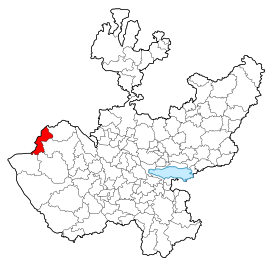 Location of the municipality within the state of Jalisco | |
| Coordinates: 20°38′45″N 105°13′20″W / 20.64583°N 105.22222°W | |
| Country | Mexico |
| State | Jalisco |
| Municipality | Puerto Vallarta |
| Founded | December 12, 1851 |
| Founded as | Las Peñas |
| Named for | Ignacio Vallarta |
| Government | |
| • Municipal president | Luis Alberto Michel Rodríguez ( |
| Area | |
| • City | 49.11 km2 (18.96 sq mi) |
| • Metro | 1,452 km2 (561 sq mi) |
| • Municipality | 680.9 km2 (262.9 sq mi) |
| Elevation | 7 m (23 ft) |
| Population | |
| • City | 224,166 |
| • Density | 4,600/km2 (12,000/sq mi) |
| • Metro | 479,471 |
| • Metro density | 330/km2 (860/sq mi) |
| • Municipality | 291,839 |
| • Municipality density | 430/km2 (1,100/sq mi) |
| Demonym | Vallartense |
| Time zone | UTC−6 (Central Central Standard Time) |
| • Summer (DST) | UTC−6 (Central Standard Time) |
| Postal code | 48300 |
| Area code | +52 322 |
| Website | puertovallarta |
Puerto Vallarta (Spanish pronunciation: [ˈpweɾto βaˈʎaɾta] or simply Vallarta) is a Mexican beach resort city on the Pacific Ocean's Bahía de Banderas in the Mexican state of Jalisco. Puerto Vallarta is the second largest urban agglomeration in the state after the Guadalajara Metropolitan Area. The City of Puerto Vallarta is the government seat of the Municipality of Puerto Vallarta, which comprises the city as well as population centers outside of the city extending from Boca de Tomatlán to the Nayarit border (the Ameca River). The city is located at 20°40′N 105°16′W / 20.667°N 105.267°W. The municipality has an area of 681 square kilometres (262.9 sq mi). To the north, it borders the southwest of the state of Nayarit. To the east, it borders the municipality of Mascota and San Sebastián del Oeste, and to the south, it borders the municipalities of Talpa de Allende and Cabo Corrientes.[4]
Puerto Vallarta is named after Ignacio Vallarta, a former governor of Jalisco. In Spanish, Puerto Vallarta is frequently shortened to "Vallarta", while English speakers call the city P.V. for short. In Internet shorthand, the city is often referred to as PVR, after the International Air Transport Association airport code for its Gustavo Diaz Ordaz International Airport.
Puerto Vallarta's proximity to the Bay of Banderas, the agricultural valley of the Ameca River, and the important mining centers in the Sierra have given the town a more interesting past[clarification needed] than most Mexican tourist destinations. Puerto Vallarta was a thriving Mexican village long before it became an international tourist destination. Tourism is a major economic activity because of the climate, scenery, tropical beaches, and rich cultural history. The early village name for Puerto Villarta was Tintoque and the name Tintoque Puerto Villarta is still used formally to describe the city.[citation needed]
|
Main article: Playa de los Muertos (Puerto Vallarta) |
In the 16th century, Hernán Cortés explored the Pacific side of Mexico by ship. Cortés used the established port of Acapulco to resupply and anchor his ships along the journey. During the early 1500s, he sent two of his ships North to explore the coastline without him. One of his ships wrecked in Banderas Bay and all but three men were reportedly killed. It is believed the corpses of the lost sailors washed ashore. Native villagers encountered numerous corpses on the beach for days after the wreck. [5]
Pirates were known to attack ships along the Pacific Coast of Mexico as early as the 16th century. In the early 1500s the famous explorer Hernán Cortés set out to establish a safe harbor, north of Acapulco, to provide protection for cargo ships sailing the planned Manila galleon trade route to the Philippines. Just several hundred miles north, he discovered a large bay at the village of Tintoque. According to local legend, pirates were already anchoring in this bay and regularly pillaged local villagers while burying treasure in the hills. When Cortes and his crew set foot on the beach, a mob of angry villagers believed he and his crew were pirates and surrounded them with native weapons in hand. According to his journal, a Catholic friar accompanying the crew began praying to the Lord for help. Villagers were mesmerized by the red flags the crew carried and suddenly lowered their weapons, allowing the explorers to pass peacefully. It's likely the villagers had seen the flags before when they floated ashore with the dead crew from a Cortés ship that wrecked earlier in the bay. This is how the Bahía de Banderas was named. Francisco Cortés de Buenaventura, the nephew of Hernán Cortés, is said to have formalized the bay's name during his own conquering of the region in 1525. In the following years, Tintoque became a major port and safe harbor for ships traveling the Manila galleon. [6][7]
Few details are known about the history of the area prior to the 19th century. There is archaeological evidence to suggest continuous human habitation from 580 BC, and similar evidence (from sites near Ixtapa and in Col. Lázaro Cárdenas)[8] that the area belonged to the Aztlán culture which dominated Jalisco, Nayarit and Michoacán from c. 900–1200. The limited evidence in occidental Mexican archeology have limited the current knowledge about pre-historic life in the area.[9]
The official founding story of Las Peñas and thus of Puerto Vallarta is that it was founded by Guadalupe Sánchez Torres, his wife Ambrosia Carrillo and some friends such as Cenobio Joya, Apolonio de Robles, Cleofas Peña and Martín Andrade, among others, on December 12, 1851, and was given the name of Las Peñas de Santa María de Guadalupe since it was the day dedicated to the virgin of Guadalupe. Although the purchase record of the property by Guadalupe Sanchez is dated 1859, his family lived there prior to the purchase year.[10][11] Also even as early as 1850 the area was already peopled by fishermen, pearl divers, smugglers and foragers, all of whom had something of a permanent existence in the area. Given the existing historical documents it is simply impossible to date the first permanent settlement in the area.
There is however no doubt the development of Las Peñas into a self-sustaining village of any significant size happened in the 1860s as the mouth of the Cuale area was exploited to support the operations of the newly enfranchised Union en Cuale company. As such 1859 marks the beginning of Puerto Vallarta as a village. Twenty years later, by 1885, the village comprised about 250 homes and about 800 residents.[12]
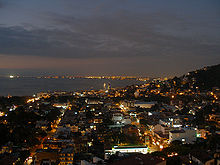
Six factors in the 1960s and 1970s launched Puerto Vallarta into becoming a major resort destination.
The Mexican federal government resolved century-old property disputes of land that had communal status, land the federal government had appropriated from the Union en Cuale mining company during the Mexican Revolution to be parceled out as communal farms. The land's communal (ejido) status had stifled development in the town for much of the 20th century. A significant transition of communal lands into private ownership within present Puerto Vallarta city limits took place in 1973 with the establishment of the Vallarta Land Trust (Fideicomiso) to oversee selling government land into private hands, and using the sales revenue to develop the city's infrastructure.[citation needed] American director John Huston filmed his 1964 movie The Night of the Iguana in Mismaloya, a small town just south of Puerto Vallarta. During the filming, the US media gave extensive coverage to Elizabeth Taylor's extramarital affair with Richard Burton, as well as the frequent fighting between Huston and the film's four stars. The publicity helped put Puerto Vallarta on the map for US tourists.[citation needed]

The Mexican government invested significantly in transportation improvements, making Puerto Vallarta an easy travel destination. To make Puerto Vallarta accessible by jet aircraft the government developed the city's international airport. Ground transportation significantly improved. Government invested heavily in the development of highway and utility infrastructure. Another vital improvement for the city was the El Salado wharf (where the current cruise terminal is), inaugurated on June 1, 1970, making Puerto Vallarta Jalisco's first harbor town.[13]
During the mid-1980s, Puerto Vallarta experienced a rapid expansion of impromptu communities poorly served by even basic public services. This very low standard of living leveled out Puerto Vallarta's resort boom. In the late 1980s Puerto Vallarta's government worked to alleviate the situation by developing housing and infrastructure. But the legacy of the 1980s boom remains, as the outlying areas of Puerto Vallarta suffer from poor provision of basic services (i.e. water, sewage, roads).[14]

Puerto Vallarta lies on a narrow coastal plain at the foot of the Sierras Cuale and San Sebastián, parts of the Sierra Madre Occidental. The plain widens to the north, reaching its widest point along the Ameca river. Three rivers flow from the Sierra through the area. From south to north they are the Cuale, the Pitillal, and the Ameca. A number of arroyos also run from the Sierra to the coastal plain. Many of the valleys of these rivers and arroyos are inhabited. Also development has to some extent spread up the hillsides from the coastal plain.
The city proper comprises four main areas: the hotel zone along the shore to the north, Olas Altas – Colonia Emiliano Zapata to the south of the Cuale river (recently named Zona Romántica in some tourist brochures), the Centro along the shore between these two areas, and a number of residential areas to the east of the hotel zone. The oldest section of the town is the area of Col. Centro near the church of Our Lady of Guadalupe, especially Hidalgo street.
Puerto Vallarta, like much of the west coast of North America, is prone to earthquakes, though Puerto Vallarta tends to experience only peripheral effects of earthquakes centered farther south. On 9 October 1995, an earthquake located off the Colima coast shook the crown from the top of the Roman Catholic Church.[15][16]
Puerto Vallarta has a Tropical wet and dry climate (Köppen climate classification Aw), with dry winters and rainy summers.[17] The average daily high temperature is 86 °F (30 °C); average daily low temperature is 70 °F (21 °C); average daily humidity is 75%. The rainy season extends from mid June through mid October, with most of the rain between July and September. August is the city's wettest month, with an average of 14 days with significant precipitation. Even during the rainy season precipitation tends to be concentrated in large rainstorms. Occasional tropical storms will bring thunderstorms to the city in November, though the month is typically dry. There is a marked dry season in the winter. February, March and April are the months with the least cloud cover.[18]
Prevailing winds are from the southwest, and most weather systems approaching Puerto Vallarta are consequently weakened as they pass over Cabo Corrientes. Thus even during the rainy season Puerto Vallarta's weather tends to be mild compared to other areas along the Mexican Pacific coast.
Hurricanes seldom strike Puerto Vallarta. In 2002, Hurricane Kenna, a category 5 hurricane, made landfall about 160 km (100 mi) northwest of Puerto Vallarta, and the city suffered some damage from the resulting storm surge. In 1971, Hurricane Lily, a category 1 hurricane, caused serious flooding on the Isla Cuale, prompting the city to relocate all of its residents to the new Colonia Palo Seco.
| Climate data for Puerto Vallarta, Jalisco, Mexico | |||||||||||||
|---|---|---|---|---|---|---|---|---|---|---|---|---|---|
| Month | Jan | Feb | Mar | Apr | May | Jun | Jul | Aug | Sep | Oct | Nov | Dec | Year |
| Record high °C (°F) | 35.0 (95.0) |
35.0 (95.0) |
36.0 (96.8) |
36.0 (96.8) |
43.5 (110.3) |
45.0 (113.0) |
45.0 (113.0) |
39.0 (102.2) |
38.0 (100.4) |
39.0 (102.2) |
37.0 (98.6) |
36.0 (96.8) |
45.0 (113.0) |
| Mean daily maximum °C (°F) | 26.7 (80.1) |
26.7 (80.1) |
27.2 (81.0) |
27.8 (82.0) |
29.4 (84.9) |
31.7 (89.1) |
32.2 (90.0) |
32.2 (90.0) |
32.2 (90.0) |
31.7 (89.1) |
30.0 (86.0) |
27.8 (82.0) |
29.6 (85.4) |
| Daily mean °C (°F) | 21.7 (71.1) |
21.7 (71.1) |
22.2 (72.0) |
23.6 (74.5) |
25.6 (78.1) |
28.3 (82.9) |
28.6 (83.5) |
28.3 (82.9) |
28.3 (82.9) |
27.8 (82.0) |
25.3 (77.5) |
22.8 (73.0) |
25.4 (77.6) |
| Mean daily minimum °C (°F) | 16.7 (62.1) |
16.7 (62.1) |
17.2 (63.0) |
18.9 (66.0) |
21.7 (71.1) |
25.0 (77.0) |
25.0 (77.0) |
24.4 (75.9) |
24.4 (75.9) |
23.9 (75.0) |
20.6 (69.1) |
17.8 (64.0) |
21.0 (69.9) |
| Record low °C (°F) | 11 (52) |
8 (46) |
12 (54) |
11 (52) |
11 (52) |
17 (63) |
21 (70) |
21 (70) |
18 (64) |
16 (61) |
13 (55) |
7 (45) |
7 (45) |
| Average rainfall mm (inches) | 33.8 (1.33) |
5.3 (0.21) |
2.0 (0.08) |
1.5 (0.06) |
15.4 (0.61) |
187.6 (7.39) |
328.1 (12.92) |
312.4 (12.30) |
370.0 (14.57) |
93.8 (3.69) |
19.8 (0.78) |
22.5 (0.89) |
1,392.2 (54.83) |
| Average rainy days (≥ 0.1 mm) | 2.2 | 0.7 | 0.6 | 0.2 | 1.0 | 10.8 | 16.4 | 15.2 | 15.6 | 5.1 | 1.4 | 1.9 | 71.1 |
| Average relative humidity (%) | 67 | 65 | 65 | 67 | 68 | 69 | 69 | 70 | 70 | 68 | 67 | 68 | 68 |
| Source 1: World Meteorological Organization.[19] | |||||||||||||
| Source 2: Weatherbase[20] | |||||||||||||
| Jan | Feb | Mar | Apr | May | Jun | Jul | Aug | Sep | Oct | Nov | Dec |
|---|---|---|---|---|---|---|---|---|---|---|---|
| 24 °C (75 °F) | 24 °C (75 °F) | 24 °C (75 °F) | 25 °C (77 °F) | 27 °C (81 °F) | 28 °C (82 °F) | 29 °C (84 °F) | 30 °C (86 °F) | 30 °C (86 °F) | 30 °C (86 °F) | 28 °C (82 °F) | 25 °C (77 °F) |
Hurricane Patricia, a Category 5 storm, became the most powerful cyclone ever measured in the Western Hemisphere with sustained wind speeds up to 200 mph (320 km/h). Hurricane Patricia was forecast to make landfall at Puerto Vallarta on the evening of October 23, 2015, with catastrophic damage predicted for the town and surrounding areas and the potential for mud slides. The storm changed from a Category 1 to a Category 5 in just 24 hours, thus catching some vacationers off guard and leaving many trapped in the town. The Jalisco state government put together 30 buses to evacuate tourists from the coast to Guadalajara, a 5-hour ride inland. Manzanillo, Colima was also near the forecast catastrophic damage zone. Ultimately, Patricia made landfall south of Puerto Vallarta, sparing the city from any significant damage.[22][23]
Nearly 80% of the workforce is employed in tourist related industries: hotels, restaurants, personal services, and transportation.[24]

Puerto Vallarta was once named as La ciudad más amigable del mundo (The Friendliest City in the World), as the sign reads when entering from Nayarit.
Tourism in Puerto Vallarta has increased steadily over the years and makes up 80% of the city's economic activity in 2020.[24] The high season for international tourism in Puerto Vallarta is from late November through March (or later, depending on the timing of the college spring break period in the U.S.) The city is especially popular with U.S. residents from the southern and western U.S. because of the number of direct flights between Puerto Vallarta and Atlanta, Los Angeles, San Francisco, Seattle, Denver, Phoenix, Dallas/Fort Worth, Houston, Minneapolis/St Paul and Chicago.[25] It is also popular with tourists from Canada with a number of direct scheduled and charter flights from major Canadian cities.

Puerto Vallarta is also a highly popular vacation spot for domestic tourists. It is a popular weekend destination for residents of Guadalajara (tapatíos), and a popular national destination for vacations such as Semana Santa (the week preceding Easter) and Christmas. As Acapulco has experienced a rise in drug-related violence,[26] Puerto Vallarta has absorbed much of the Mexico City resort vacation business (Acapulco has long been a common destination for tourists from Mexico City).
Rapid growth in tourist volume in Puerto Vallarta has given rise to rapid growth in hotel and rental apartment construction. This growth has spilled over from the city limits into Nuevo Vallarta in the neighboring state of Nayarit.[citation needed]

Puerto Vallarta has become a popular retirement destination for U.S. and Canadian retirees. This has created a number of neighborhoods within the Puerto Vallarta region that cater primarily to real estate tourism, such as the Hotel Zone, which stretches from downtown Vallarta to the airport and Marina Vallarta (near the airport), and Amapas and Conchas Chinas, which are built into the mountain slightly south and behind Puerto Vallarta, and overlook the city and bay. Most recently the downtown area, especially in Emiliano Zapata (also known as the Romantic Zone), has seen a somewhat controversial trend of traditional homes being razed for the construction of condominium buildings. This region in recent years has been the most popular for Vallarta real estate tourism, with nearly 25% of all real estate sales for the region taking place there in 2019.[27]

The Vallarta tourism real estate tourism market is made up of both full-time retirees and a second-home owners, primarily from the United States. On average about 40% of buyers are American, with Mexican nationals consisting of 30% and Canadians and other foreign buyers making up the remaining 20%. Mexicans favor destinations such as Puerto Vallarta, Los Cabos and Cancún not just for the sun and beach, but also as real estate investment to hedge their pesos as real estate in these regions is priced in USD, rather than in pesos like the rest of the country.[27]
Puerto Vallarta can be classified as a medium-ranged real estate market with a market consisting mostly of condominiums with the average price around US$320,000 in 2019.[27] Any foreigner wishing to buy real estate in Puerto Vallarta (or anywhere along the coast of Mexico), can't own real estate there outright, but needs to establish a fideicommissum or beneficial trust which is held with a Mexican bank on the owner's behalf. It is not the same as holding the title. The trust is good for 50 years and can be renewed for another 50-year period.[28]
|
Main article: LGBT culture in Puerto Vallarta |
|
See also: LGBT tourism |
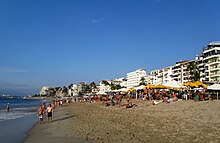
Guadalajara and Acapulco were common vacation destinations for gay men and lesbians from Mexico City and, especially, the United States and Canada in the 1980s and 1990s.[citation needed] But since that time, Puerto Vallarta has developed into Mexico's premier resort town as a sort of satellite gay space for its big sister Guadalajara, much as Fire Island is to New York City and Palm Springs is to Los Angeles.[29] It is now considered the most welcoming and gay-friendly destination in the country, dubbed the "San Francisco of Mexico."[30] Previously quite conservative, the municipal government has become increasingly supportive in recognising and accepting the LGBT tourism segment and supporting LGBT events such as Vallarta gay pride celebrations, which launched in 2013 and are now held annually to coincide with U.S. Memorial Day weekend.[31] It boasts a gay scene, centered in the city's south-side Zona Romántica, of hotels and resorts as well as many bars, nightclubs and a gay beach on the main shore.[30] Puerto Vallarta has been cited as the number one gay beach destination in Latin America,[32] with city officials claiming a 5% tourism increase in 2013.[33]
The major suburb is Bahia de Banderas in Nayarit across state lines, in which Nuevo Vallarta and Sayulita are localities. Ixtapa is a locality in PV, not to be confused with the municipality of Ixtapa in Guerrero state.
| 1950 | 1960 | 1970 | 1980 | 1990 | 1995 | 2000 | 2005 | 2010 | 2014est/2015 | |
|---|---|---|---|---|---|---|---|---|---|---|
| Locality Population (city) | 93,503 | 121,844 | 151,432 | 177,830 | 203,342 | 221,200 | ||||
| Municipality | 10,801 | 15,462 | 35,911 | 57,028 | 111,457 | 184,728 | 255,725 | 275,640 |
sources: (locality & 2015 municipal) [34] (municipal to 2010) sources: Cuaderno Estadistico Municipal[35] Censo de Poblacion y Vivienda 2010.[36]
Poverty remains a problem in Puerto Vallarta, fueled by the constant influx of persons seeking employment. Many areas of the city are still poorly served by roads and sewers. For example, Colonia Ramblases is served by roads in generally poor condition only 10% of which are paved, and Ramblases has been a populated neighborhood since the 1940s.[37]
The Municipality of Puerto Vallarta comprises about 45,000 regular dwellings. Of those, 10% do not have a potable water supply (carrying their water from a public tap), 8% do not have connections to a sewer system or septic system (using instead crude septic pits or dumping sewage directly into waterways), and 4% do not have electricity.[38] One reason for this is the difficulty the city has enforcing building regulations.
Many of the jobs available in Puerto Vallarta are classed as inferior by the Secretariat for Social Development, and even jobs that are generally well paying tend to be seasonal, so for example, waiters depend heavily on tips to supplement incomes that can be as low as 80 pesos a day – the applicable minimum wage in Jalisco.[39] There have recently (2005 to 2007) been improvements, such as new IMSS facilities in Col. Versalles, improvements to several recreation facilities, improved communal beach access policies, etc. Still efforts seem to aim more at quick and visible infrastructure improvements than at solving the more pressing and enduring problem of insufficient infrastructure for basic services.[40]
One positive result of recent growth has been that in relative terms a smaller percentage of the population lives in older and poorly served neighborhoods. A growing number of residents live in housing projects and low-income housing developments which provide at least adequate basic services.[41]

The Licenciado Gustavo Díaz Ordaz International Airport comprises a commercial international section and a general aviation section.[42] The commercial section has a single runway, 3,300 m (10,700 ft) in length and 46 m (150 ft) in width, capable of handling all current traffic without restrictions.

The port of Puerto Vallarta receives cruise ships on a regular basis during the tourist season. The docks (Muelle de Cruceros Puerto Vallarta) can berth three cruise ships simultaneously. Trips to the El Centro old town and its beach front and tourist markets, including some art stores, are available. The beach front has been recently undergoing additional improvements to the Malecon, a long promenade along the beach with numerous sculptures, restaurants, night clubs, access to boat-pulled paragliding over the bay, and various other tourist specific activities and markets.
National bus lines connect Puerto Vallarta (via the Central Camionera near the Modelo building north of town near the airport) with Guadalajara, Mazatlán, Manzanillo and points beyond. Bus lines include ETN and Primera Plus. Smaller bus lines connect Puerto Vallarta to small coastal and sierra towns.[citation needed]
Puerto Vallarta currently has no passenger rail service. Historically, buses connected with nearby Tepic, where there was a passenger rail service on the main north–south trunk of Ferromex. Heading north, trains continued to Nogales, opposite its namesake in Arizona. A spur headed northwest to Mexicali, opposite Calexico, California. Service to the east went to Guadalajara and then to Mexico City.[43]
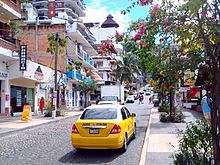
Puerto Vallarta is serviced by three municipal bus unions that provide coverage for most of the greater Puerto Vallarta area (e.g. Ixtapa, Mismaloya, Pitillal). Most of the population of the Municipality of Puerto Vallarta travels by municipal bus. Automobile ownership is not rare, but cars are seldom used to commute to and from work. They are typically reserved for family outings and major shopping trips.
As of June 2017, Uber began operating in Puerto Vallarta.[44] Their arrival has not been without conflict, as there have been confrontations between them due to their much lower rates.[45]
|
Main article: List of municipal presidents of Puerto Vallarta |
Puerto Vallarta has schools for all levels from kindergarten to university education both private and public.
Puerto Vallarta has a campus from one of the best known universities in Mexico, the University of Guadalajara. But it also has many other lesser known public and private university options such as the UNIVA university and the Instituto Tecnologico de Puerto Vallarta (Puerto Vallarta Technological Institute). Some of these universities also offer high school level education.




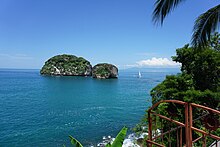
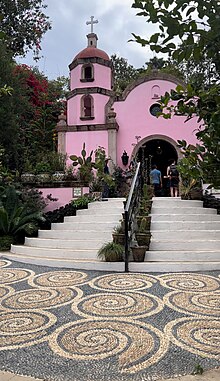
South Shores beaches A number of beaches along the South shore of the bay are accessible only by boat from mismaloya beach. The developed beaches include (east to west): Las Animas, Quimixto, Majahuitas and Yelapa. These and other smaller undeveloped beaches can be reached by launch from Boca de Tomatlán.
The north shore of the bay is lined with beach towns that offer good wading beaches and the usual tourist amenities. These include (east to west): Bucerias, Cruz de Huanacaxtle, Playa la Manzanilla, Playa Destiladeras, Playa Pontoque, and Punta Mita, all in the State of Nayarit. All can be reached by bus (departing from Wal-Mart).
Puerto Vallarta comprises numerous neighborhoods (colonias). Notable neighborhoods include (from South to North)
The city also includes numerous fraccionamientos, densely built residential blocks that provide affordable housing for the city's workforce.
Additionally the municipality of Puerto Vallarta comprises a few other significant population centers (from South to North):